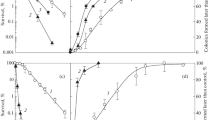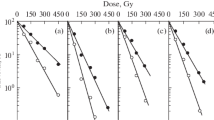Summary
The lethal and cytoplasmic mutagenic effects of 52°C incubation during the cell cycle of a haploid strain of Saccharomyces cerevisiae were examined. Both effects varied periodically in a rather parallel pattern: the maximum thermosensitivity was seen at budding time, corresponding to the S period (Williamson, 1965). The 52°C induction of a nuclear forward mutation was also examined: canavanine-resistant mutants were induced by this treatment. Exponentially growing cells were much more sensitive than resting cells to the different effects of heating which were studied. On the other hand, on comparing asynchronous cultures of 6 different radiosensitive mutants only one (xrs5) showed a greater thermosensitivity than the corresponding wild type.
Similar content being viewed by others
References
Bachetti, S., Cassandro, M., Mauro, F.: Radiosensitivity in relation to the cell cycle and recovery from X-ray sublethal damage in diploid yeast. Exp. Cell Res. 46, 292–300 (1967).
Bridges, B. A., Ashwood-Smith, M. J., Munson, R. J.: Correlation of bacterial sensitivities to ionizing radiation and mild heating. J. gen. Microbiol. 58, 115–124 (1969).
Byfield, J. E., Scherbaum, O. H.: Suppression of RNA and protein accumulation by temperature shifts in a heat-synchronized protozoan. Life Sci. 5, 2263–2269 (1966).
Carnevalli, F., Piperno, G., Tecce, G.: Satellite components of DNA from a cytoplasmic “petite” mutant of Saccharomyces cerevisiae. Rend. sc. Fis. Mat. e Nat. 41, 194–196 (1966).
Chanet, R.: Étude de l'évolution de l'effet létal et mutagène cytoplasmique des ultraviolets dans des cultures synchrones de souches de radiosensibilité différente de Saccharomyces cerevisiae. Diplôme d'Etudes Approfondies, Faculté des Sciences, Orsay, 1971.
Cox, B. S., Parry, J. M.: The isolation, genetics and survival characteristics of UV light sensitive mutants in yeast. Mutation Res. 6, 37–55 (1968).
Esposito, R. E.: Genetic recombination in synchronized cultures of Saccharomyces cerevisiae. Genetics 59, 191–210 (1968).
Evenson, D. P., Prescott, D. M.: Disruption of DNA synthesis in Euplotes by heat shock. Exp. Cell Res. 63, 245–252 (1970).
Game, J. C., Cox, B. S.: Allelism tests of mutants affecting sensitivity to radiation in yeast and a proposed nomenclature. Mutation Res. 12, 328–331 (1971).
Gause, F. G., Kusovkova, L. I.: Temperature sensitivity in the respiratory deficient mutants of yeast. Experientia (Basel) 26, 209–210 (1970).
Ginoza, W., Zimm, B. H.: Mechanisms of inactivation of deoxyribonucleic acids by heat. Proc. nat. Acad. Sci. (Wash.) 47, 639–652 (1961).
Heiberg, B.: Die Thermoresistenz bei jungen und alten Bakterien und „jungen” und „alten” Bakteriophagen. Z. ges. Hyg. 114, 425–428 (1933).
Latarjet, R., Morenne, P., Berger, R.: Un appareil simple pour le dosage des rayonnements ultraviolets émis par les lampes germicides. Ann. Inst. Pasteur 85, 174–184 (1953).
Levine, E. M., Robbins, E. B.: Differential temperature sensitivity of normal and cancer cells in culture. J. cell. Physiol. 76, 373–380 (1970).
Louderback, A. L., Sherbaum, O. H., Jahn, T. L.: The effect of temperature shifts on the budding cycle of Saccharomyces cerevisiae. Exp. Cell Res. 25, 437–454 (1961).
Matsumoto, S., Kagami-Ishi, Y.: The temperature dependence of mortality rate of radiosensitive strains of E. coli and Saccharomyces cerevisiae. Jap. J. Genet. 45, 153–160 (1970).
Mitchison, J. M., Vincent, W. S.: Preparation of synchronous cell cultures by sedimentation. Nature (Lond.) 205, 987–989 (1965).
Mounolou, J. C., Jakob, H., Slonimski, P. P.: Mitochondrial DNA from yeast “petite” mutants: specific changes of buoyant density corresponding to different cytoplasmic mutations. Biochem. biophys. Res. Commun. 24, 218–224 (1966).
Moustacchi, E.: Cytoplasmic and nuclear genetic events induced by UV light in strains of Saccharomyces cerevisiae with different UV-sensitivities. Mutation Res. 7, 171–185 (1969).
Mukkerjee, P., Bhattacharjee, S. B.: Recovery of bacteria from damages induced by heat. J. gen. Microbiol. 60, 233–238 (1970).
Muller, H. J.: The measurement of gene mutation rate in Drosophila, its high variability and its dependence upon temperature Genetics 13, 279–357 (1928).
Nagley, P., Linnane, A. W.: Mitochondrial DNA deficient petite mutants of yeast. Biochem. biophys. Res. Commun. 39, 989–996 (1970).
Ogur, M., St John, R.: A differential and diagnostic plating method for population studies of respiration deficiency in yeast. J. Bact. 72, 500–504 (1956).
Ogur, M., St John, R., Nagai, S.: Tetrazolium overlay technique for population studies of respiration deficiency in yeast. Science 125, 928–929 (1957).
Parry, J. M., Parry, E. M.: The effects of UV light post-treatments on the survival characteristics of 21 UV-sensitive mutants of Saccharomyces cerevisiae. Mutation Res. 8, 545–556 (1969).
Plough, H. H.: The effect of temperature on crossing-over in Drosophila. J. exp. Zool. 24 143–209 (1917).
Pollard, E. C., Solosko, W.: The thermal inactivation of T4 and λ bacteriophages. Biophys. J. 11, 66–74 (1971).
Resnick, M. A.: Genetic control of lethality and mutation in Saccharomyces cerevisiae. Ph. D. Thesis, University of California UCRL-18404 (1968).
Roger, M., Hotchkiss, R. D.: Selective heat inactivation of pneumococcal transforming deoxyribonucleate. Proc. nat. Acad. Sci. (Wash.) 47, 653–669 (1961).
Rosenberg, A. M., Wood, T. H.: The modifying effect of culture age on heat sensitivity of yeast. Exp. Cell Res. 12, 692–694 (1957).
Rosenthal, L. J., Iandolo, J. J.: Thermally induced intracellular alterations of ribosomal ribonucleic acid. J. Bact. 103, 833–835 (1970).
Schulze, C.: Die Anwendung des Pasteurisierens gegen Nachgärungen der Weine auf den Flaschen. Landwirtsch. Jahrb. 24, 403–433 (1895).
Sherman, F.: The heat inactivation and production of cytochrome deficiency in yeast. Exp. Cell Res. 11, 659–660 (1956).
Sherman, F.: A study of the effects of elevated temperatures on the growth and inheritance of Saccharomyces cerevisiae. Ph. D. Thesis, University of California, UCRL-8573 (1958).
Sogin, S. J., Ordal, Z. J.: Regeneration of ribosomes and ribosomal ribonucleic acid during repair of thermal injury to Staphylococcus aureus. J. Bact. 94, 1082–1087 (1967).
Suslova, N. G., Zakharov, I. A.: The gene controlled radiation sensitivity of yeast. VII. Identification of the genes for the X-ray sensitivity. Genetica 6, 158–163 (1970).
Westra, A., Dewey, W. C.: Variation in sensitivity to heat shock during the cell cycle of Chinese hamster cells in vitro. Int. J. Radiat. Biol. 19, 467–477 (1971)
Wiame, J. M., Bechet, J., Mousset, M., Deken Grenson M. de: Mise en évidence d'une perméase de l'arginine chez Saccharomyces cerevisiae. Arch. int. Physiol. Biochim. 70, 766–767 (1962).
Williamson, D. H.: Division synchrony in yeasts. In: Synchrony in cell division and growth. Zeuthen, New York: John Wiley & Sons 1964.
Williamson, D. H.: The timing of deoxyribonucleic acid synthesis in the cell cycle of Saccharomyces cerevisiae. J. Cell Biol. 25, 517–528 (1965).
Williamson, D. H., Moustacchi, E.: The synthesis of mitochondrial DNA during the cell cycle in the yeast Saccharomyces cerevisiae. Biochem. biophys. Res. Commun. 42, 195–201 (1971).
Woese, C.: Thermal inactivation of animal viruses. Ann. N.Y. Acad. Sci. 83, 741–751 (1960).
Wood, T. H.: Lethal effects of high and low temperatures on unicellular organisms. Advanc. biol. med. Phys. 4, 119–165 (1956).
Zamenhof, S.: Effects of heating dry bacteria and spores on their phenotype and genotype. Proc. nat. Acad. Sci. (Wash.) 46, 101–105 (1960).
Zamenhof, S., Greer, S.: Heat as an agent producing high frequency of mutations and unstable genes in E. coli. Nature (Lond.) 182, 611–613 (1958).
Author information
Authors and Affiliations
Additional information
Communicated by B. A. Bridges
Rights and permissions
About this article
Cite this article
Schenberg-Frascino, A., Moustacchi, E. Lethal and mutagenic effects of elevated temperature on haploid yeast. Molec. Gen. Genet. 115, 243–257 (1972). https://doi.org/10.1007/BF00268888
Received:
Issue Date:
DOI: https://doi.org/10.1007/BF00268888




